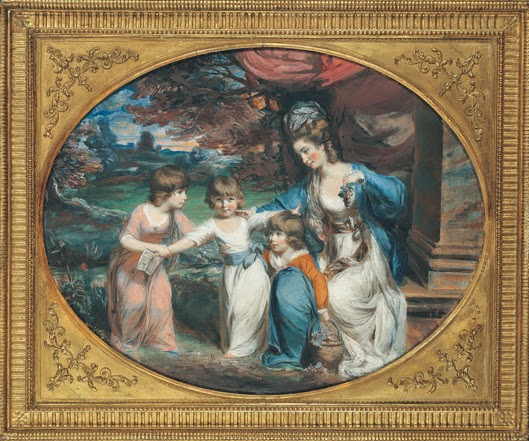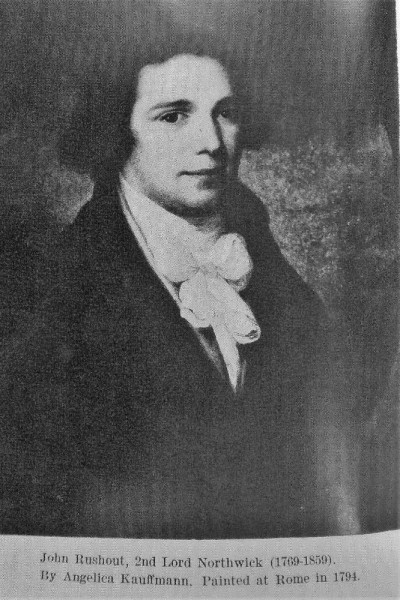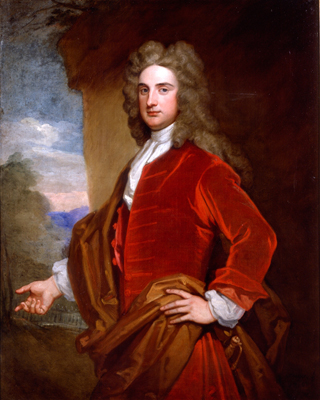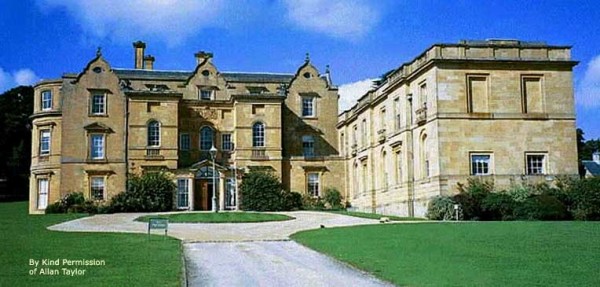Who was Lord Northwick?
In the annals of art history the important art collection of John 2nd Lord Northwick, who died in 1859, is referred to frequently – but with little attention to detail, particularly in relation to the man himself and his collecting. One reason for this is the fact that he did not marry, and therefore no son to inherit. But the main reason is that he appears not to have made a Will – at least one could not be found – which necessitated the enforced Sale of his collection. My concern in this series of essays is predominantly with his collection of paintings – but his enormous collection included much more – works on paper (watercolours, prints, and drawings), applied art (cameos, gems, coins, and ‘antiquities’), as well as books and manuscripts. Items from his entire collection have found their way into major collections in this country and abroad – and a Northwick provenance is of enormous value, not least in the Sale Room.
In this first essay I am concerned with attempting an initial picture of the man – someone who did not seek publicity and thus no iconic painted portrait as there was with most other collectors. The only visual records seem to be from his youth – first as a young child with his mother and two sisters – secondly a portrait by his family’s favourite painter, Angelika Kauffmann, whilst he was on his Grand Tour, a work which appeared briefly in a mid twentieth century sale and has now again disappeared into obscurity.
Daniel Gardner : ‘Lady Rushout with her three children’ : c1774
Angelika Kauffmann : ‘Sir John Rushout’ (later 2nd Lord Northwick) : 1794.
Family History
The family history of the Northwick’s is difficult to unravel partly because it seemed to suffer greatly from frequent early deaths and the lack of sons to carry on a direct line – and it was only in 1797 that the baronetcy of Northwick was granted, a title which John, the 1st Lord Northwick, did not long enjoy dying in 1800. Rushout was the family name and whilst early history of the family is uncertain things become clearer from the early seventeenth century when John Rushout, a native of France, settled in London and listed as a Flemish Merchant. He seemed to have quickly settled in and became a wealthy man – acquiring Northwick Park, in the village of Blockley which straddled the Gloucestershire and Worcestershire boundary, as his country seat, soon to be regarded as the main family home. Clearly influential and desirous of further social and political development he arranged for his son James, then 17 years old, to be created Baron of Maylards(possibly later ‘Maylords’) in the county of Essex. James was ambitious and hard working becoming the MP for the constituency in which Northwick Park was sited. After several early deaths the fourth Baronet, Sir John Rushout, took up his title in 1711. He was an active politician and served as Treasurer of the Navy in 1743/4 when he was made a Privy Counsellor and from 1762 to 1768 he was Father of the House of Commons. He died in 1775 aged ninety.
Godfrey Kneller : Sir John Rushout, 4th Baronet : 1685-1775
The Fourth baronet was succeeded by his son, also John, who benefited from his father’s work and aspirations by being elevated to the peerage as the First Lord Northwick in 1797 – but not for long as he died in 1800. The title then passed to his son, another John, who was the subject of these essays, the 2nd Lord Northwick, born in 1770. Unlike many of his contemporaries the second lord was not educated at one of the major Public Schools, or at one of the two English Universities – instead his parents sent him abroad for his teenage education. In 1790 he embarked on an extensive Grand Tour – visiting several European countries but particularly Italy. Our John took the Grand Tour very seriously and enthusiastically embarked upon it in a spirit of eager enquiry – quickly making several important serious contacts including Edward Gibbon, Sir William Hamilton and his wife Emma, Horatio Nelson, and Richard Payne Knight – as well as several major artists including Antonio Canova (sculptor) and Vincenzo Camuccini (painter). Europe seemed constantly in the grip of continuing political, and thus military, conflict which – as well as often appalling travel conditions – made for an exciting life. It was whilst staying with friends at Palermo that the British ship HMS Vanguard was temporarily stranded in the Bay which meant that John and his friends were arguably the first English people to receive the news of the Victory of the Battle of the Nile – from Nelson himself! The upheavals in Europe, particularly Italy, did provide possible rich pickings for collectors as ancient family collections were sold off by their impoverished owners. John Rushout found himself, with the help of expert advice and contacts, in an exciting world of possibilities. Not for him the pleasures of wine and the flesh – his fellow young travellers appeared to have despaired by the fact he much preferred chasing up collecting possibilities. His early forays into collecting, advised by the knowledgeable William Hamilton and Payne-Knight, started with smaller items such as coins, intaglios and cameos, and gems – but also venturing into prints and the occasional painting. As he approached ten years immersed in his adventures and discoveries abroad news came of the serious illness of his father – who died in 1800.
Early Years – 1800 to 1838.
On his return to England he was faced with several family, or family related, properties in various parts of the country – the central one being Northwick Park at Blockley (then in Gloucestershire and later in Worcestershire) with significant property, house and estate, in Middlesex and Essex – as well as a London residence. In the first few years he began to rationalise, where he could, these various properties and their responsibilities – something which he was good at and developed as a very capable and forward looking, and caring, landowner. Now, with considerable wealth and income from his farmland and estates, he could (in his spare time!!) develop his collecting. It is apparent that whilst he collected much in the way of antiquities and books his main interest was increasingly upon paintings and the world of art. He enthusiastically got involved in the cultural life of London – joining such bodies as the Society of Antiquaries and the Dilettanti Society, attending regularly the art sales held at Christies Auction Rooms, and actively involved in the setting up bodies concerned with bringing art to the public such as the British Institution (founded in 1805). It was not long before he became a recognised and familiar figure in the art world and although we have no portraits of him (it must have been his decision) we do get a glimpse of him by George Redford in his marathon work ‘Art Sales’, published in the late nineteenth century, as follows :-
‘He (Lord Northwick) was a most pleasant and cheerful gentleman, extremely simple and unpretending in his manner, with a slight, rather short, figure, and a face, round, smiling, and fresh in complexion. I remember him well as an ‘habitué’ of Christies, more than forty-two years ago, and in summer he generally wore a suit of Nankeen, a kind of cool dress which has long since disappeared.’
Northwick Park, Blockley : post 1832
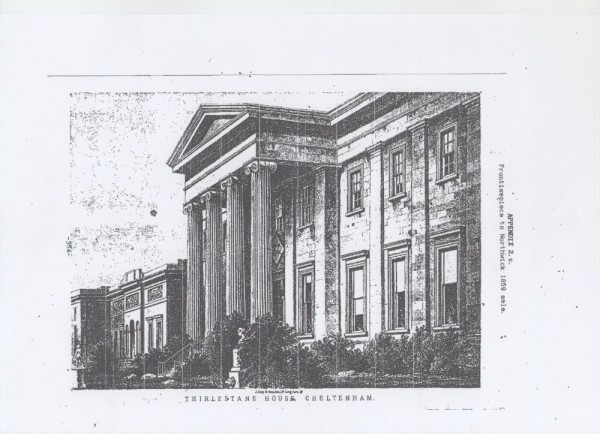 Thirlestaine House : Cheltenham : c1846
Thirlestaine House : Cheltenham : c1846
It is clear from the manuscript evidence of the family that Lord Northwick began seriously collecting in the early decades of the century and developed serious contact with major dealers and other collectors. One practical result was lack of space for hanging this rapidly expanding collection of paintings – a problem he started to resolve by buying a new London property in Connaught Place, a new and exclusive development adjacent to Hyde Park. There is evidence that from the 1820’s he welcomed visitors to view his works – both young and old. The breathing (or hanging) space of Connaught Place was not to last long – he had built a large purpose-built art gallery extension to Northwick Park in the early 1830’s. But even this was to prove inadequate – and Lord Northwick, planning ahead and now firmly established in the art and collecting world, sought to buy something bigger outside London. It was in 1838 that he decided upon a large neo-classic mansion on the outskirts of Cheltenham – Thirlestaine House – and quickly sold his London house in Connaught Place. At the same time he put up a considerable number of paintings for sale by Christies – many of which remained in his collection – which suggested he was doing something he regularly did – ‘weeding , with their hanging space potential, provided a further boost to his collecting. It was Thirlestaine House which now began considerable expansion – almost every few years between 1840 and 1855 new galleries were built. In other essays I shall deal with aspects of the collection at Thirlestaine House but here I note that Lord Northwick’s wish to share his collection with the public became evident from the early days of his arrival. The local weekly magazine, the ‘Cheltenham Looker-On’ began, in the early 1840’s, a series of articles on the paintings at Thirlestaine House – which quickly developed into a published catalogue, which was revised and re-published several times over the next twelve years, the last one being a year before his death in 1859.
1859 – Death of the Northwick Collection.
The 2nd Lord Northwick died not long before what would have been his ninetieth birthday – to nationwide as well as local mourning. But his death proved to be the death of the collection he had so carefully built up over decades – because no Will could be found and, being unmarried, he had no son and heir meaning that the whole collection had to be sold. The great twenty-one day sale, with other smaller sales in 1860, was conducted by the then rival to Christies – Phillips – at Thirlestaine House, with works coming in from Northwick Park. The national press followed every day and every sale, every price and every purchaser – it was a major national event which has gone down in history. The tragic fact is that the majority of works have ‘disappeared’ – some have appeared in the collections of major purchasers but these too, when sold off, have ‘disappeared’ – a relatively few now appear in major collections such as the National Gallery in London and other British public collections (Cheltenham has two works) – and quite few now appear in major USA collections and elsewhere world-wide. The heir to the 2nd Lord Northwick , the 3rd Lord Northwick, acquired or kept quite a number of important works which were dispersed at the death of his heir, Capt Spencer-Churchill, in the 1960’s – again to disappear into purchaser anonymity. As to Thirlestaine House – the family did not wish to be burdened with it and, eventually, sold it to the great, but reclusive, collector of books and manuscripts Sir Thomas Phillipps. At his death the burden fell heavily on his fractured family who eventually managed to sell it to Cheltenham College in 1948.

